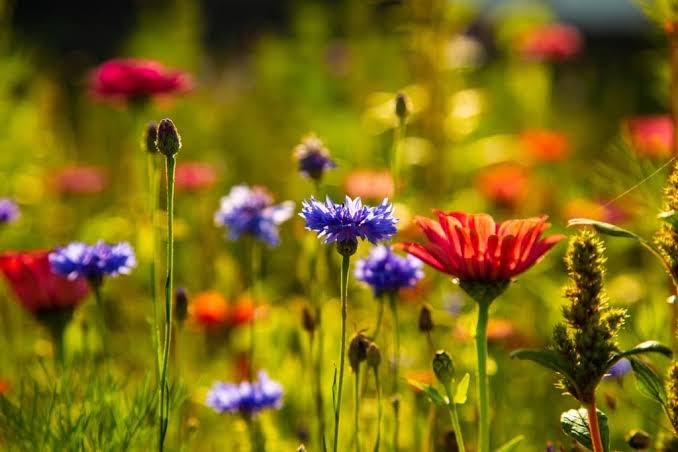Wildflowers bring effortless beauty, color, and charm to any garden. Whether you want to create a vibrant cottage-style garden, a buzzing pollinator haven, or a simple low-maintenance meadow, wildflowers are the perfect solution. The best part? Planting them is far easier than most people think. With a few smart tricks, you can enjoy a space filled with natural blooms that thrive in your climate without constant upkeep.In this guide, we’ll share easy how to plant wildflowers hacks you’ll want to save. From soil prep to seed scattering, these tips will help you grow a breathtaking wildflower patch in the United States, United Kingdom, or Canada.🌸 Why Wildflowers Deserve a Spot in Your GardenBefore diving into hacks, let’s look at why wildflowers are so special:Low Maintenance – Once established, they require little water and care.Pollinator Friendly – Attract bees, butterflies, and even hummingbirds.Eco-Friendly – Wildflowers improve biodiversity and support local ecosystems.Cost-Effective – A single packet of seeds can cover a large area.Natural Beauty – They bring effortless color and texture without looking overplanned.🌿 Hack #1: Choose the Right Wildflower Mix for Your RegionNot all wildflowers thrive everywhere. The key to success is selecting seeds suited to your climate.In the US, you’ll find regional wildflower seed blends (e.g., Northeast, Midwest, or California native mixes).In the UK, look for meadow wildflower blends that include species like cornflowers, oxeye daisies, and poppies.In Canada, native options like black-eyed Susans, lupines, and wild bergamot do well.👉 Pro Tip: Always check if the mix is native to your region—this ensures stronger growth and helps the environment.🌱 Hack #2: Prep Your Soil Without OverthinkingYou don’t need perfect soil for wildflowers, but a little prep goes a long way.Clear away grass, weeds, and debris.Loosen the top 2–3 inches of soil with a rake or hoe.Avoid adding fertilizer—wildflowers prefer nutrient-poor soil (too much fertility can encourage weeds instead).This hack creates the ideal bed for seeds to germinate and thrive naturally.🌼 Hack #3: Mix Seeds with Sand for Even DistributionOne of the easiest mistakes is scattering seeds too densely. A smart hack is to mix seeds with dry sand before sowing.Ratio: 1 part seed to 4 parts sand.This helps spread them evenly across your planting area.Result? A balanced, natural-looking wildflower meadow with no overcrowding.🌸 Hack #4: Water Lightly, Not ExcessivelyAfter scattering seeds, gently water the soil to help them settle in. But avoid overwatering—wildflowers don’t like soggy soil.First 2–3 weeks: Keep soil lightly moist until seeds germinate.After establishment: Water only during long dry spells.This hack ensures healthy growth without creating mold or rot.🌺 Hack #5: Embrace the “Scatter and Forget” MethodIf you’re short on time, wildflowers are your best friend. The scatter and forget method works surprisingly well:Choose a patch of open soil.Scatter your seeds evenly.Lightly rake them into the soil or press them down with your hands.Walk away and let nature do its thing!This low-effort hack is especially handy for creating a natural meadow look.🦋 Hack #6: Attract Pollinators with a Mix of Bloom TimesWant butterflies and bees visiting your garden all season long? Plant a mix of wildflowers with staggered bloom times.Early bloomers: Poppies, lupines, daisiesMid-season bloomers: Coneflowers, black-eyed Susans, cosmosLate bloomers: Asters, goldenrod, sunflowersThis ensures your wildflower patch stays colorful from spring through fall.🌷 Hack #7: Plant in Fall or Early SpringTiming is everything when it comes to wildflowers.Fall planting (before the ground freezes) allows seeds to undergo natural stratification (cold treatment) and bloom beautifully in spring.Early spring planting works well for quick germination when the soil warms up.👉 In colder climates like Canada, fall planting often produces the best results.🌹 Hack #8: Don’t Mow Too SoonOnce your wildflowers bloom, resist the urge to mow them down too early.Wait until late fall to mow or cut back.This allows flowers to drop seeds and reseed naturally for next year.It’s one of the easiest hacks to ensure a self-sustaining wildflower patch.🌸 Hack #9: Mix in Grass for a Meadow EffectWant a more natural “wild meadow” vibe? Mix low-growing grasses with wildflowers.Great choices include:FescueTimothy grassRyegrassThis creates a fuller look, prevents erosion, and helps wildflowers stand out beautifully.🌼 Hack #10: Start Small and ExpandIf you’re new to wildflowers, don’t plant your entire yard at once. Start with a small section, learn how they grow, and expand each year.This hack keeps the process fun, manageable, and far less overwhelming.✅ Quick Wildflower Planting ChecklistHere’s a handy summary of wildflower hacks you’ll want to save:🌸 Pick regional or native wildflower mixes.🌿 Prep soil by clearing weeds but skip fertilizer.🌱 Mix seeds with sand for even sowing.💧 Water lightly until established.🌺 Try the scatter-and-forget method.🦋 Mix early, mid, and late bloomers.🌷 Plant in fall or early spring.🌹 Let flowers reseed by mowing late.🌼 Add grass for a meadow look.✅ Start small and expand yearly.ConclusionPlanting wildflowers is one of the easiest ways to create a colorful, eco-friendly, low-maintenance garden. With these easy how to plant wildflowers hacks, you can transform a dull patch of soil into a vibrant field that supports pollinators and delights the eye from spring through fall.Whether you’re in the US, UK, or Canada, these simple tricks—like mixing seeds with sand, planting at the right time, and letting nature do the work—make wildflower gardening stress-free and rewarding.So grab a packet of seeds, scatter them in your favorite spot, and let the magic of wildflowers unfold. 🌸🌿✨

